Stewardship and Governance: Evaluating Block's Model and Nike's Case
VerifiedAdded on 2021/06/17
|7
|1612
|13
Essay
AI Summary
This essay delves into the concepts of stewardship and governance, defining stewardship as holding something in trust. It examines Peter Block's model of stewardship, which emphasizes authentic service to redistribute power, purpose, and wealth within organizations. The essay summarizes Block's model, highlighting the importance of accountability, authentic service, and redesigning management practices. It explores the potential outcomes of adopting stewardship, including a balanced distribution of power, a new organizational purpose, and the redistribution of wealth. The essay then critiques Block's model, acknowledging the reliance on top management. It also analyzes the benefits and challenges of implementing Block's model at Nike, particularly regarding its contractors. The essay concludes by emphasizing the practical relevance of Block's model in business contexts, using the hypothetical case of Nike to illustrate its application.
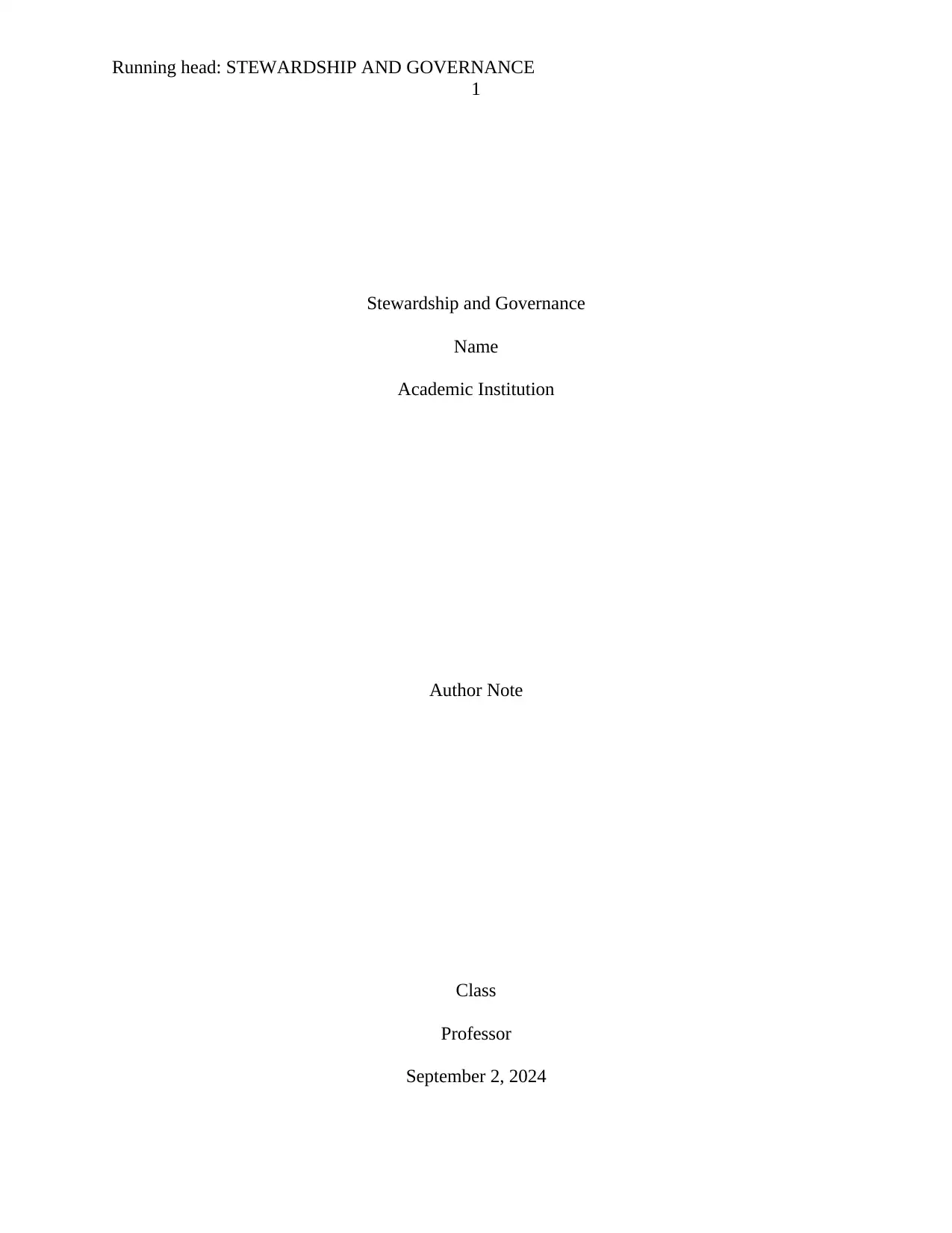
Running head: STEWARDSHIP AND GOVERNANCE
1
Stewardship and Governance
Name
Academic Institution
Author Note
Class
Professor
September 2, 2024
1
Stewardship and Governance
Name
Academic Institution
Author Note
Class
Professor
September 2, 2024
Paraphrase This Document
Need a fresh take? Get an instant paraphrase of this document with our AI Paraphraser
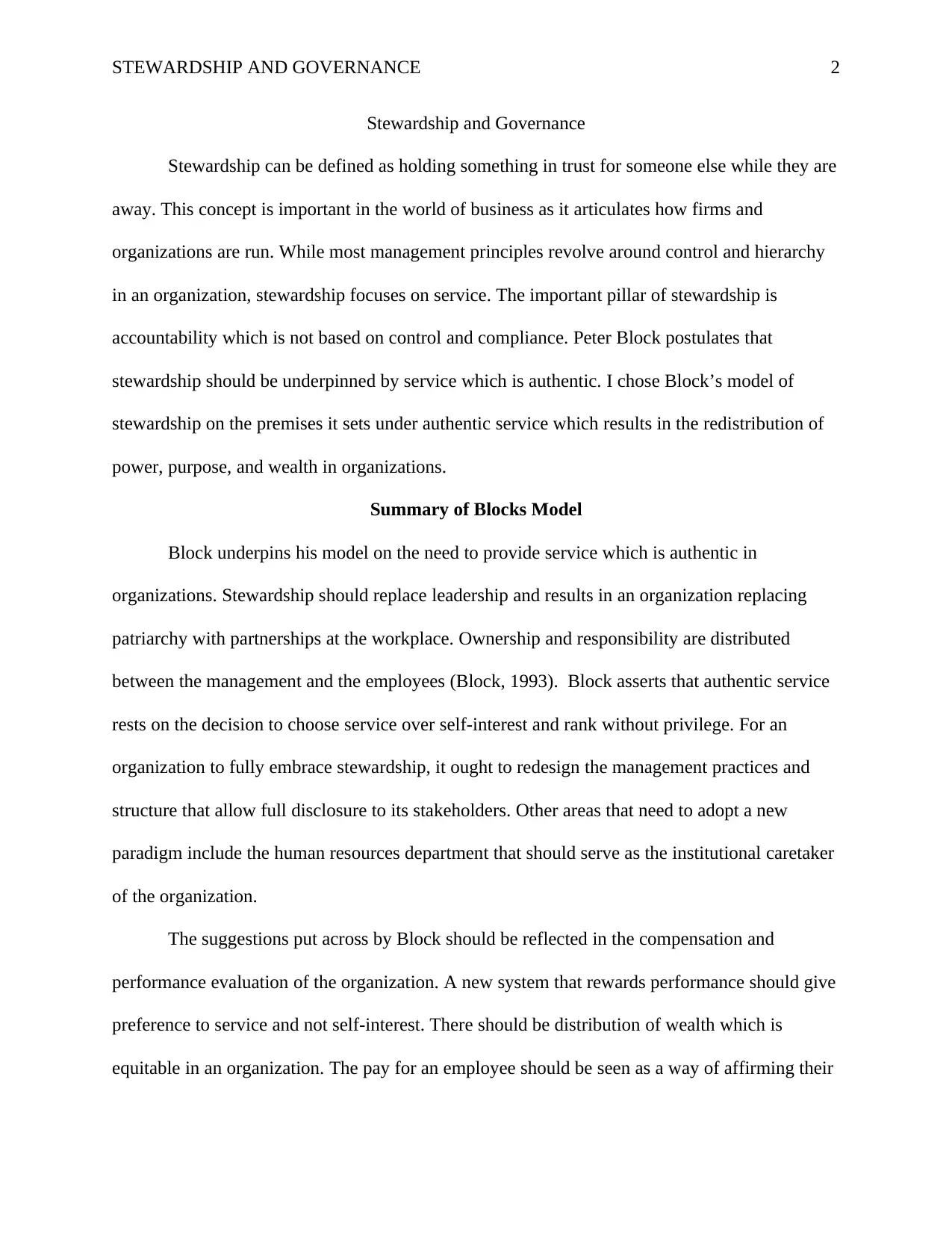
STEWARDSHIP AND GOVERNANCE 2
Stewardship and Governance
Stewardship can be defined as holding something in trust for someone else while they are
away. This concept is important in the world of business as it articulates how firms and
organizations are run. While most management principles revolve around control and hierarchy
in an organization, stewardship focuses on service. The important pillar of stewardship is
accountability which is not based on control and compliance. Peter Block postulates that
stewardship should be underpinned by service which is authentic. I chose Block’s model of
stewardship on the premises it sets under authentic service which results in the redistribution of
power, purpose, and wealth in organizations.
Summary of Blocks Model
Block underpins his model on the need to provide service which is authentic in
organizations. Stewardship should replace leadership and results in an organization replacing
patriarchy with partnerships at the workplace. Ownership and responsibility are distributed
between the management and the employees (Block, 1993). Block asserts that authentic service
rests on the decision to choose service over self-interest and rank without privilege. For an
organization to fully embrace stewardship, it ought to redesign the management practices and
structure that allow full disclosure to its stakeholders. Other areas that need to adopt a new
paradigm include the human resources department that should serve as the institutional caretaker
of the organization.
The suggestions put across by Block should be reflected in the compensation and
performance evaluation of the organization. A new system that rewards performance should give
preference to service and not self-interest. There should be distribution of wealth which is
equitable in an organization. The pay for an employee should be seen as a way of affirming their
Stewardship and Governance
Stewardship can be defined as holding something in trust for someone else while they are
away. This concept is important in the world of business as it articulates how firms and
organizations are run. While most management principles revolve around control and hierarchy
in an organization, stewardship focuses on service. The important pillar of stewardship is
accountability which is not based on control and compliance. Peter Block postulates that
stewardship should be underpinned by service which is authentic. I chose Block’s model of
stewardship on the premises it sets under authentic service which results in the redistribution of
power, purpose, and wealth in organizations.
Summary of Blocks Model
Block underpins his model on the need to provide service which is authentic in
organizations. Stewardship should replace leadership and results in an organization replacing
patriarchy with partnerships at the workplace. Ownership and responsibility are distributed
between the management and the employees (Block, 1993). Block asserts that authentic service
rests on the decision to choose service over self-interest and rank without privilege. For an
organization to fully embrace stewardship, it ought to redesign the management practices and
structure that allow full disclosure to its stakeholders. Other areas that need to adopt a new
paradigm include the human resources department that should serve as the institutional caretaker
of the organization.
The suggestions put across by Block should be reflected in the compensation and
performance evaluation of the organization. A new system that rewards performance should give
preference to service and not self-interest. There should be distribution of wealth which is
equitable in an organization. The pay for an employee should be seen as a way of affirming their
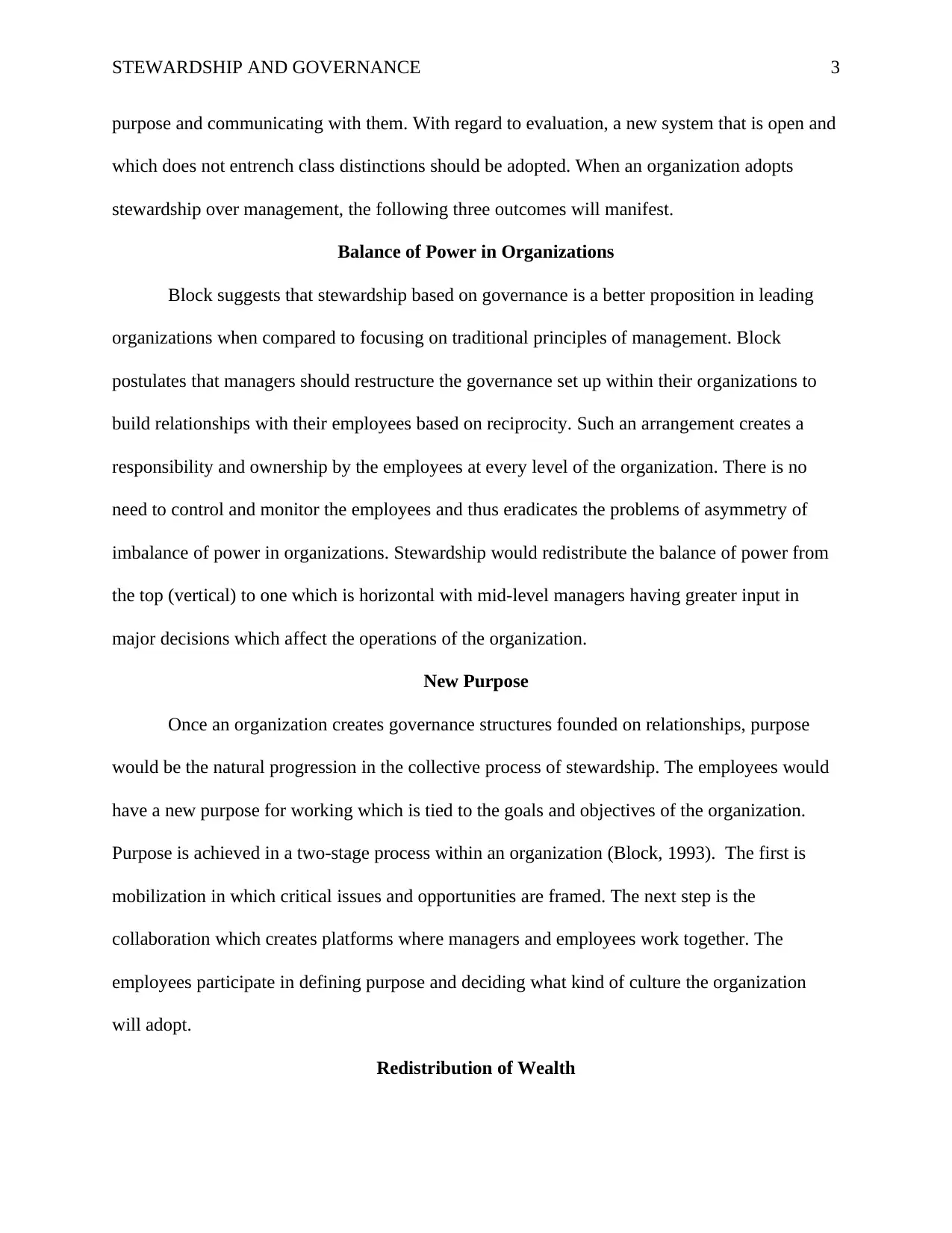
STEWARDSHIP AND GOVERNANCE 3
purpose and communicating with them. With regard to evaluation, a new system that is open and
which does not entrench class distinctions should be adopted. When an organization adopts
stewardship over management, the following three outcomes will manifest.
Balance of Power in Organizations
Block suggests that stewardship based on governance is a better proposition in leading
organizations when compared to focusing on traditional principles of management. Block
postulates that managers should restructure the governance set up within their organizations to
build relationships with their employees based on reciprocity. Such an arrangement creates a
responsibility and ownership by the employees at every level of the organization. There is no
need to control and monitor the employees and thus eradicates the problems of asymmetry of
imbalance of power in organizations. Stewardship would redistribute the balance of power from
the top (vertical) to one which is horizontal with mid-level managers having greater input in
major decisions which affect the operations of the organization.
New Purpose
Once an organization creates governance structures founded on relationships, purpose
would be the natural progression in the collective process of stewardship. The employees would
have a new purpose for working which is tied to the goals and objectives of the organization.
Purpose is achieved in a two-stage process within an organization (Block, 1993). The first is
mobilization in which critical issues and opportunities are framed. The next step is the
collaboration which creates platforms where managers and employees work together. The
employees participate in defining purpose and deciding what kind of culture the organization
will adopt.
Redistribution of Wealth
purpose and communicating with them. With regard to evaluation, a new system that is open and
which does not entrench class distinctions should be adopted. When an organization adopts
stewardship over management, the following three outcomes will manifest.
Balance of Power in Organizations
Block suggests that stewardship based on governance is a better proposition in leading
organizations when compared to focusing on traditional principles of management. Block
postulates that managers should restructure the governance set up within their organizations to
build relationships with their employees based on reciprocity. Such an arrangement creates a
responsibility and ownership by the employees at every level of the organization. There is no
need to control and monitor the employees and thus eradicates the problems of asymmetry of
imbalance of power in organizations. Stewardship would redistribute the balance of power from
the top (vertical) to one which is horizontal with mid-level managers having greater input in
major decisions which affect the operations of the organization.
New Purpose
Once an organization creates governance structures founded on relationships, purpose
would be the natural progression in the collective process of stewardship. The employees would
have a new purpose for working which is tied to the goals and objectives of the organization.
Purpose is achieved in a two-stage process within an organization (Block, 1993). The first is
mobilization in which critical issues and opportunities are framed. The next step is the
collaboration which creates platforms where managers and employees work together. The
employees participate in defining purpose and deciding what kind of culture the organization
will adopt.
Redistribution of Wealth
⊘ This is a preview!⊘
Do you want full access?
Subscribe today to unlock all pages.

Trusted by 1+ million students worldwide
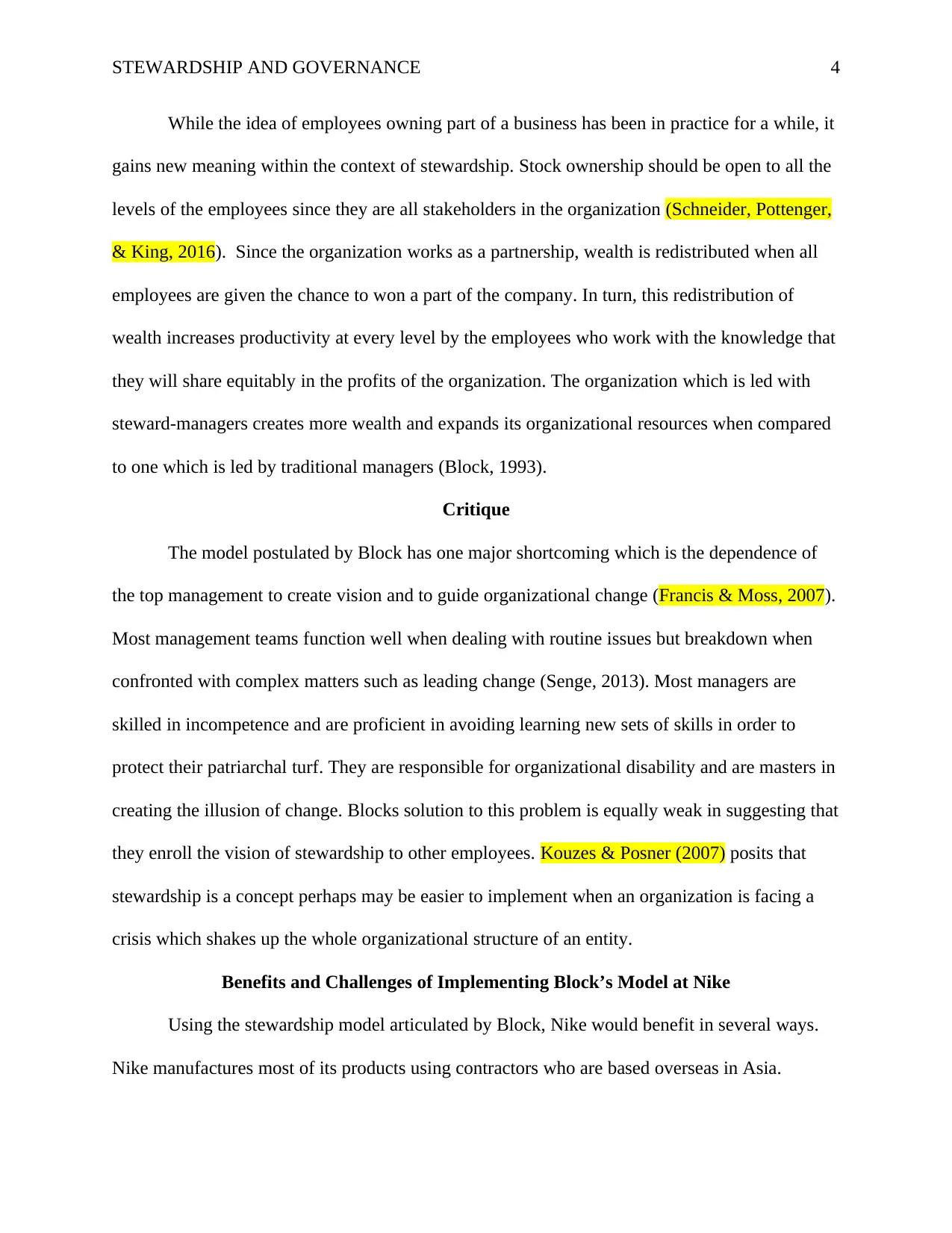
STEWARDSHIP AND GOVERNANCE 4
While the idea of employees owning part of a business has been in practice for a while, it
gains new meaning within the context of stewardship. Stock ownership should be open to all the
levels of the employees since they are all stakeholders in the organization (Schneider, Pottenger,
& King, 2016). Since the organization works as a partnership, wealth is redistributed when all
employees are given the chance to won a part of the company. In turn, this redistribution of
wealth increases productivity at every level by the employees who work with the knowledge that
they will share equitably in the profits of the organization. The organization which is led with
steward-managers creates more wealth and expands its organizational resources when compared
to one which is led by traditional managers (Block, 1993).
Critique
The model postulated by Block has one major shortcoming which is the dependence of
the top management to create vision and to guide organizational change (Francis & Moss, 2007).
Most management teams function well when dealing with routine issues but breakdown when
confronted with complex matters such as leading change (Senge, 2013). Most managers are
skilled in incompetence and are proficient in avoiding learning new sets of skills in order to
protect their patriarchal turf. They are responsible for organizational disability and are masters in
creating the illusion of change. Blocks solution to this problem is equally weak in suggesting that
they enroll the vision of stewardship to other employees. Kouzes & Posner (2007) posits that
stewardship is a concept perhaps may be easier to implement when an organization is facing a
crisis which shakes up the whole organizational structure of an entity.
Benefits and Challenges of Implementing Block’s Model at Nike
Using the stewardship model articulated by Block, Nike would benefit in several ways.
Nike manufactures most of its products using contractors who are based overseas in Asia.
While the idea of employees owning part of a business has been in practice for a while, it
gains new meaning within the context of stewardship. Stock ownership should be open to all the
levels of the employees since they are all stakeholders in the organization (Schneider, Pottenger,
& King, 2016). Since the organization works as a partnership, wealth is redistributed when all
employees are given the chance to won a part of the company. In turn, this redistribution of
wealth increases productivity at every level by the employees who work with the knowledge that
they will share equitably in the profits of the organization. The organization which is led with
steward-managers creates more wealth and expands its organizational resources when compared
to one which is led by traditional managers (Block, 1993).
Critique
The model postulated by Block has one major shortcoming which is the dependence of
the top management to create vision and to guide organizational change (Francis & Moss, 2007).
Most management teams function well when dealing with routine issues but breakdown when
confronted with complex matters such as leading change (Senge, 2013). Most managers are
skilled in incompetence and are proficient in avoiding learning new sets of skills in order to
protect their patriarchal turf. They are responsible for organizational disability and are masters in
creating the illusion of change. Blocks solution to this problem is equally weak in suggesting that
they enroll the vision of stewardship to other employees. Kouzes & Posner (2007) posits that
stewardship is a concept perhaps may be easier to implement when an organization is facing a
crisis which shakes up the whole organizational structure of an entity.
Benefits and Challenges of Implementing Block’s Model at Nike
Using the stewardship model articulated by Block, Nike would benefit in several ways.
Nike manufactures most of its products using contractors who are based overseas in Asia.
Paraphrase This Document
Need a fresh take? Get an instant paraphrase of this document with our AI Paraphraser
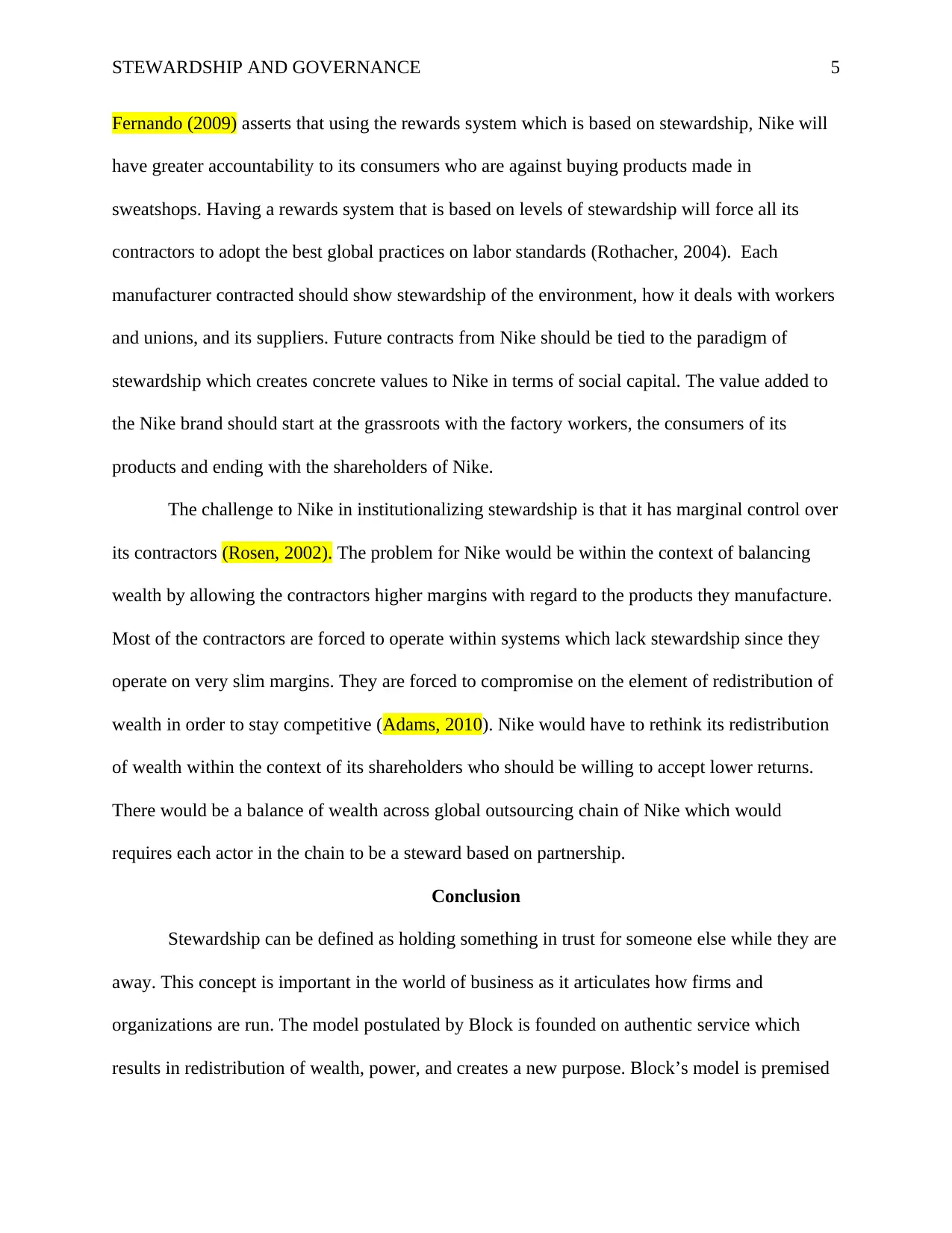
STEWARDSHIP AND GOVERNANCE 5
Fernando (2009) asserts that using the rewards system which is based on stewardship, Nike will
have greater accountability to its consumers who are against buying products made in
sweatshops. Having a rewards system that is based on levels of stewardship will force all its
contractors to adopt the best global practices on labor standards (Rothacher, 2004). Each
manufacturer contracted should show stewardship of the environment, how it deals with workers
and unions, and its suppliers. Future contracts from Nike should be tied to the paradigm of
stewardship which creates concrete values to Nike in terms of social capital. The value added to
the Nike brand should start at the grassroots with the factory workers, the consumers of its
products and ending with the shareholders of Nike.
The challenge to Nike in institutionalizing stewardship is that it has marginal control over
its contractors (Rosen, 2002). The problem for Nike would be within the context of balancing
wealth by allowing the contractors higher margins with regard to the products they manufacture.
Most of the contractors are forced to operate within systems which lack stewardship since they
operate on very slim margins. They are forced to compromise on the element of redistribution of
wealth in order to stay competitive (Adams, 2010). Nike would have to rethink its redistribution
of wealth within the context of its shareholders who should be willing to accept lower returns.
There would be a balance of wealth across global outsourcing chain of Nike which would
requires each actor in the chain to be a steward based on partnership.
Conclusion
Stewardship can be defined as holding something in trust for someone else while they are
away. This concept is important in the world of business as it articulates how firms and
organizations are run. The model postulated by Block is founded on authentic service which
results in redistribution of wealth, power, and creates a new purpose. Block’s model is premised
Fernando (2009) asserts that using the rewards system which is based on stewardship, Nike will
have greater accountability to its consumers who are against buying products made in
sweatshops. Having a rewards system that is based on levels of stewardship will force all its
contractors to adopt the best global practices on labor standards (Rothacher, 2004). Each
manufacturer contracted should show stewardship of the environment, how it deals with workers
and unions, and its suppliers. Future contracts from Nike should be tied to the paradigm of
stewardship which creates concrete values to Nike in terms of social capital. The value added to
the Nike brand should start at the grassroots with the factory workers, the consumers of its
products and ending with the shareholders of Nike.
The challenge to Nike in institutionalizing stewardship is that it has marginal control over
its contractors (Rosen, 2002). The problem for Nike would be within the context of balancing
wealth by allowing the contractors higher margins with regard to the products they manufacture.
Most of the contractors are forced to operate within systems which lack stewardship since they
operate on very slim margins. They are forced to compromise on the element of redistribution of
wealth in order to stay competitive (Adams, 2010). Nike would have to rethink its redistribution
of wealth within the context of its shareholders who should be willing to accept lower returns.
There would be a balance of wealth across global outsourcing chain of Nike which would
requires each actor in the chain to be a steward based on partnership.
Conclusion
Stewardship can be defined as holding something in trust for someone else while they are
away. This concept is important in the world of business as it articulates how firms and
organizations are run. The model postulated by Block is founded on authentic service which
results in redistribution of wealth, power, and creates a new purpose. Block’s model is premised
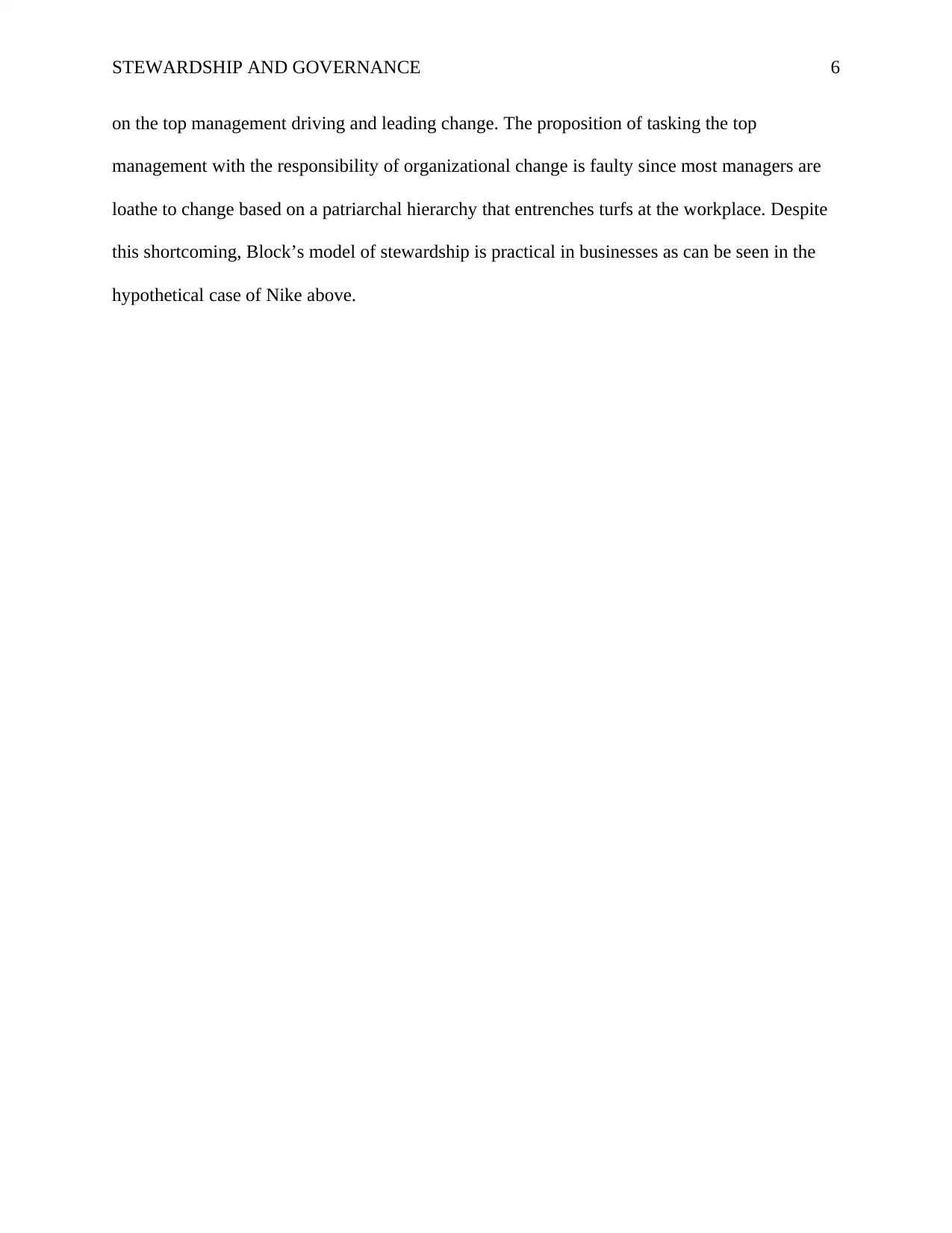
STEWARDSHIP AND GOVERNANCE 6
on the top management driving and leading change. The proposition of tasking the top
management with the responsibility of organizational change is faulty since most managers are
loathe to change based on a patriarchal hierarchy that entrenches turfs at the workplace. Despite
this shortcoming, Block’s model of stewardship is practical in businesses as can be seen in the
hypothetical case of Nike above.
on the top management driving and leading change. The proposition of tasking the top
management with the responsibility of organizational change is faulty since most managers are
loathe to change based on a patriarchal hierarchy that entrenches turfs at the workplace. Despite
this shortcoming, Block’s model of stewardship is practical in businesses as can be seen in the
hypothetical case of Nike above.
⊘ This is a preview!⊘
Do you want full access?
Subscribe today to unlock all pages.

Trusted by 1+ million students worldwide
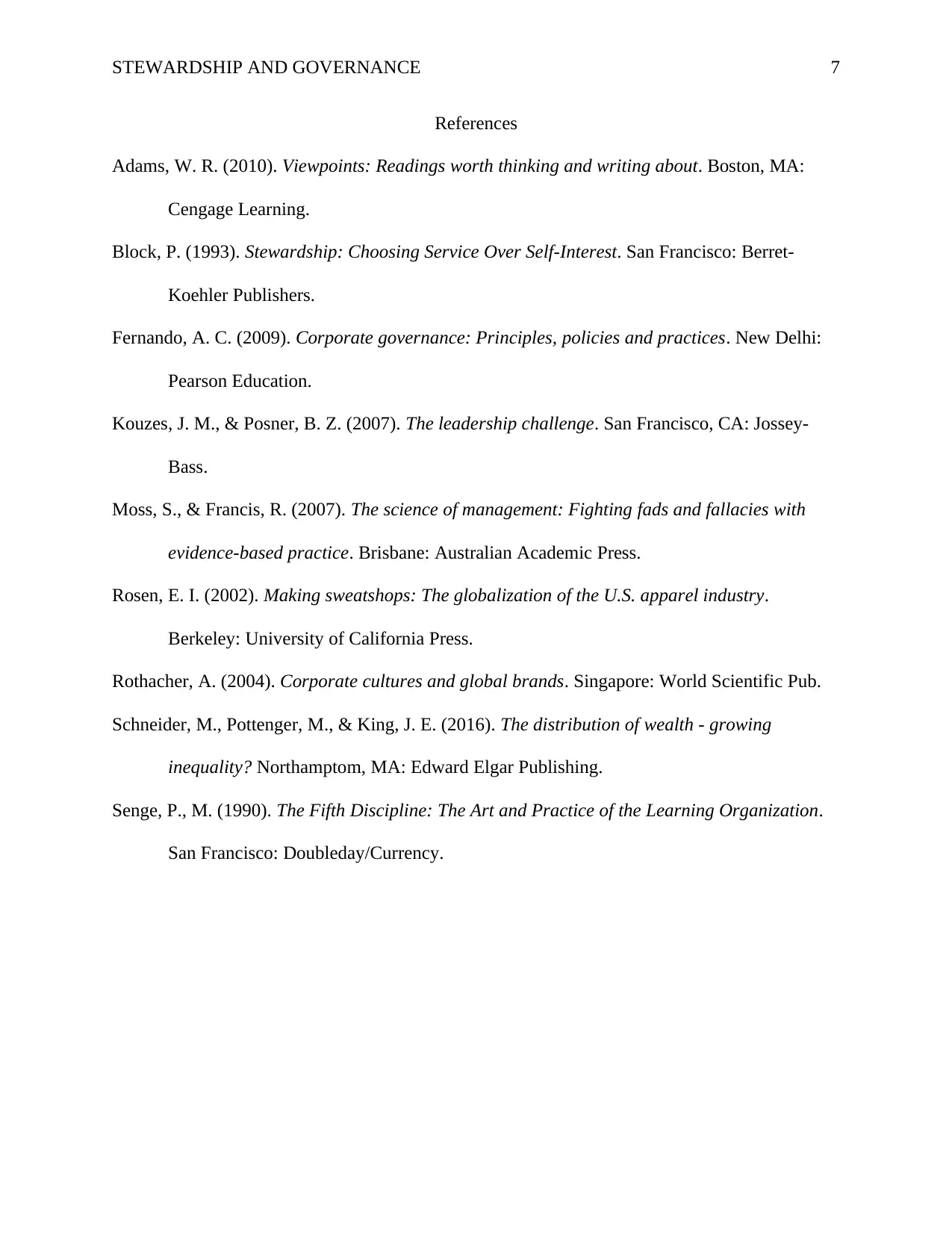
STEWARDSHIP AND GOVERNANCE 7
References
Adams, W. R. (2010). Viewpoints: Readings worth thinking and writing about. Boston, MA:
Cengage Learning.
Block, P. (1993). Stewardship: Choosing Service Over Self-Interest. San Francisco: Berret-
Koehler Publishers.
Fernando, A. C. (2009). Corporate governance: Principles, policies and practices. New Delhi:
Pearson Education.
Kouzes, J. M., & Posner, B. Z. (2007). The leadership challenge. San Francisco, CA: Jossey-
Bass.
Moss, S., & Francis, R. (2007). The science of management: Fighting fads and fallacies with
evidence-based practice. Brisbane: Australian Academic Press.
Rosen, E. I. (2002). Making sweatshops: The globalization of the U.S. apparel industry.
Berkeley: University of California Press.
Rothacher, A. (2004). Corporate cultures and global brands. Singapore: World Scientific Pub.
Schneider, M., Pottenger, M., & King, J. E. (2016). The distribution of wealth - growing
inequality? Northamptom, MA: Edward Elgar Publishing.
Senge, P., M. (1990). The Fifth Discipline: The Art and Practice of the Learning Organization.
San Francisco: Doubleday/Currency.
References
Adams, W. R. (2010). Viewpoints: Readings worth thinking and writing about. Boston, MA:
Cengage Learning.
Block, P. (1993). Stewardship: Choosing Service Over Self-Interest. San Francisco: Berret-
Koehler Publishers.
Fernando, A. C. (2009). Corporate governance: Principles, policies and practices. New Delhi:
Pearson Education.
Kouzes, J. M., & Posner, B. Z. (2007). The leadership challenge. San Francisco, CA: Jossey-
Bass.
Moss, S., & Francis, R. (2007). The science of management: Fighting fads and fallacies with
evidence-based practice. Brisbane: Australian Academic Press.
Rosen, E. I. (2002). Making sweatshops: The globalization of the U.S. apparel industry.
Berkeley: University of California Press.
Rothacher, A. (2004). Corporate cultures and global brands. Singapore: World Scientific Pub.
Schneider, M., Pottenger, M., & King, J. E. (2016). The distribution of wealth - growing
inequality? Northamptom, MA: Edward Elgar Publishing.
Senge, P., M. (1990). The Fifth Discipline: The Art and Practice of the Learning Organization.
San Francisco: Doubleday/Currency.
1 out of 7
Related Documents
Your All-in-One AI-Powered Toolkit for Academic Success.
+13062052269
info@desklib.com
Available 24*7 on WhatsApp / Email
![[object Object]](/_next/static/media/star-bottom.7253800d.svg)
Unlock your academic potential
Copyright © 2020–2025 A2Z Services. All Rights Reserved. Developed and managed by ZUCOL.





